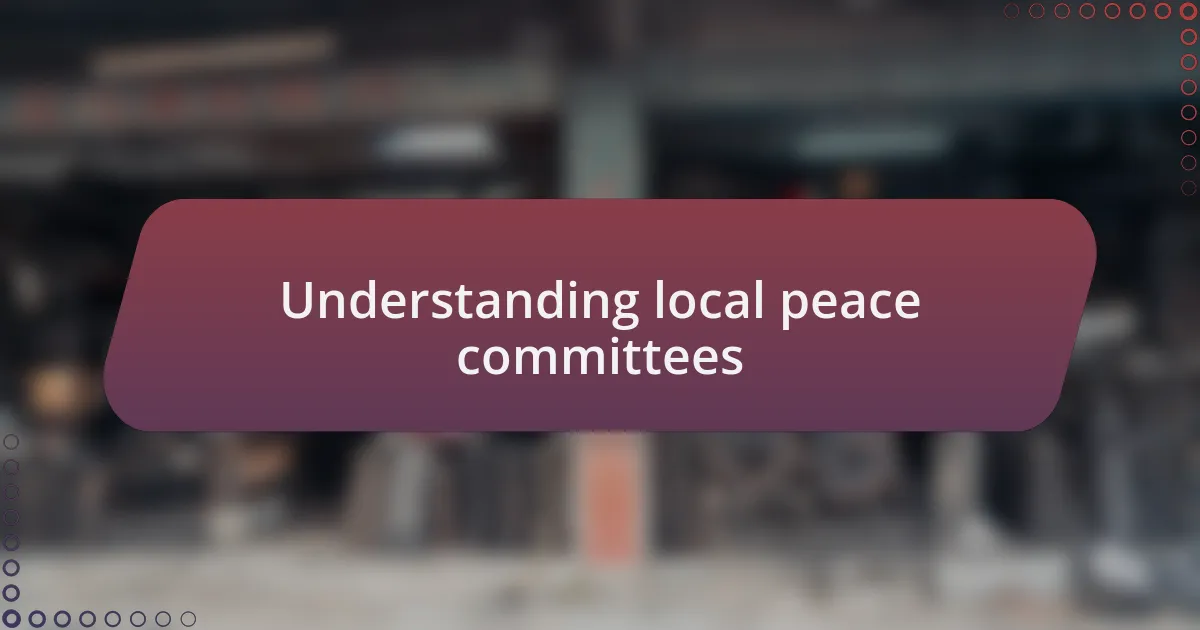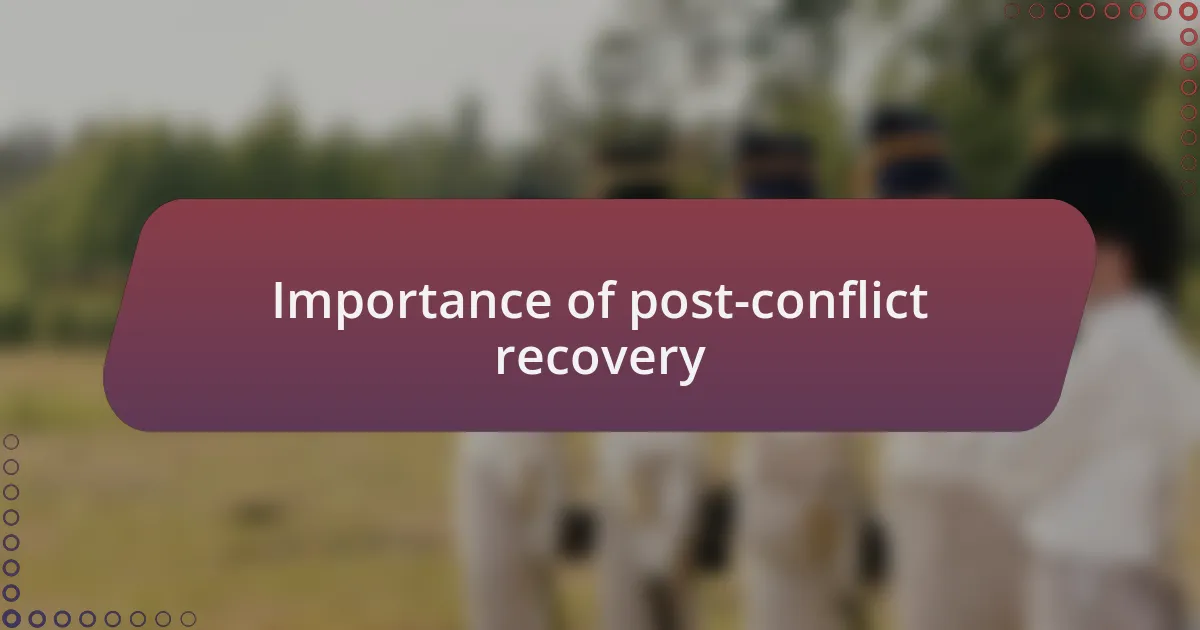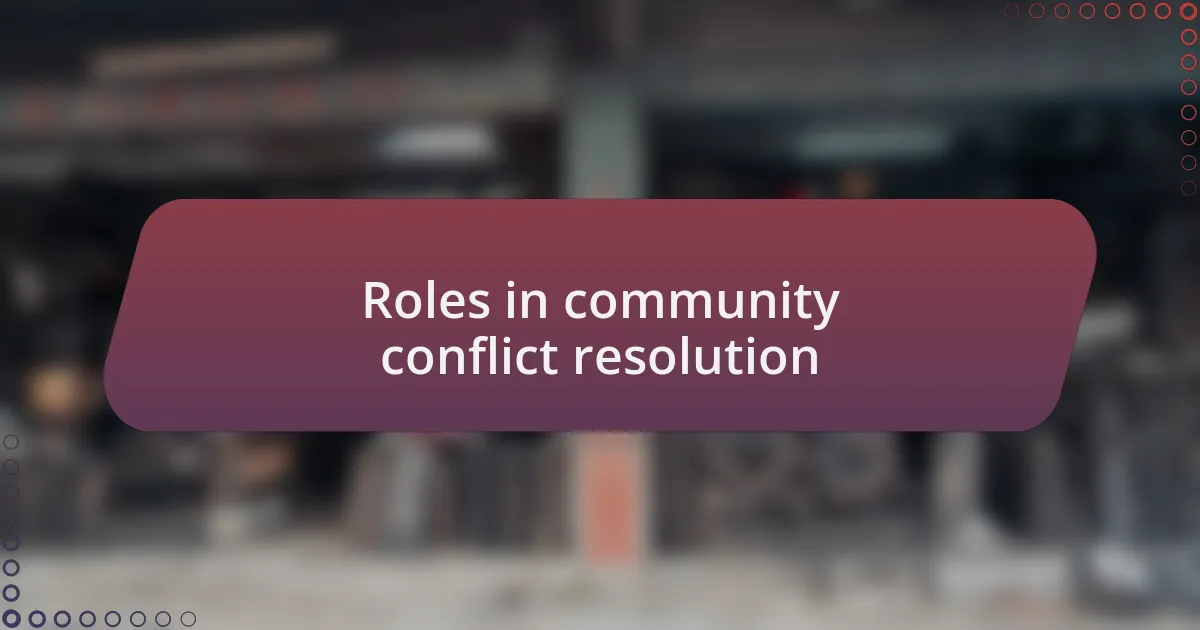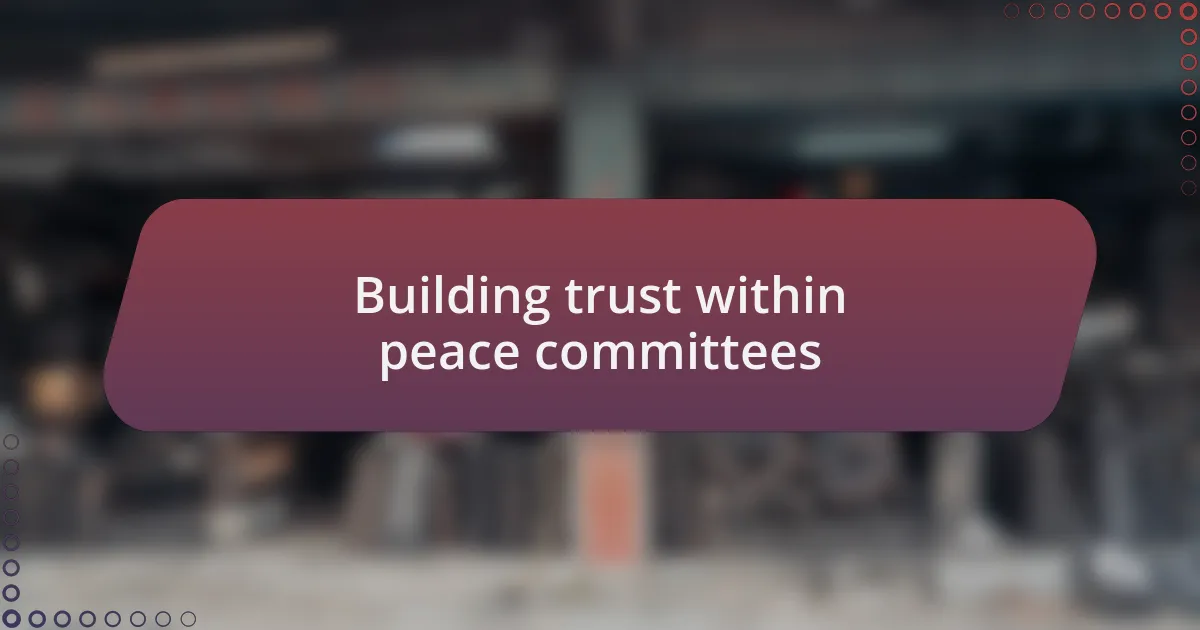Key takeaways:
- Local peace committees effectively foster empathy and cooperation through shared narratives and safe dialogue spaces.
- Post-conflict recovery initiatives help address historical grievances and empower communities to rebuild trust and relationships.
- Active participation and inclusiveness in community decision-making enhance commitment and effectiveness of peace initiatives.
- Listening, patience, and alignment on shared goals are crucial for fostering trust and collaborative conflict resolution.

Understanding local peace committees
Local peace committees serve as vital mechanisms for conflict resolution and community stability in post-conflict environments. They are often composed of diverse representatives from the community, including former combatants, women, and local leaders who all contribute to dialogue and understanding. I’ve often wondered: what makes these committees so effective in bridging divides?
In my experience, the real strength of local peace committees lies in their grassroots approach. For instance, I remember attending a committee meeting where an elder’s recounting of past grievances transformed the atmosphere. It was a poignant moment that reminded me how shared stories can foster empathy and healing. This shared narrative often acts as a catalyst for cooperation, enabling members to envision a collective future beyond their past conflicts.
Engaging in these committees can be both rewarding and challenging. I recall a time when a difficult conversation about land disputes took place; stakeholders held differing views, yet the willingness to listen was palpable. In that moment, I realized that local peace committees are not just about resolving disputes—they’re about creating safe spaces for dialogue, where every voice matters, and every story is valued. How can we encourage more such open dialogues within our own communities?

Importance of post-conflict recovery
The importance of post-conflict recovery cannot be overstated, as it lays the groundwork for lasting peace and stability. I’ve witnessed firsthand how communities that prioritize recovery are better able to rebuild trust and relationships after conflict. When I participated in recovery initiatives, I felt a palpable shift in community dynamics, as residents began to collaborate on projects that celebrated their shared identities rather than their divisions.
Moreover, post-conflict recovery serves as a platform for addressing underlying grievances that fuel future tensions. I remember a workshop where a simple discussion on resource allocation led to a deeper understanding of historical inequalities. This experience highlighted for me that acknowledging past injustices is essential for preventing the resurgence of conflict. Isn’t it fascinating how opening up space for dialogue can change the course of an entire community?
Ultimately, investing in post-conflict recovery means empowering individuals to not only heal but also thrive. I’ve seen communities flourish when they take ownership of their recovery processes. It seems to me that facilitating education and economic opportunities can transform former combatants into advocates for peace. How often do we consider the potential ripple effects of such empowerment in our discussions about recovery?

Roles in community conflict resolution
In my experience with community conflict resolution, the role of a mediator is crucial. I remember sitting between two factions in a meeting, feeling the tension in the air. By listening actively and validating their emotions, I could create a safe space for dialogue, which ultimately led to breakthrough understanding. Isn’t it amazing how sometimes all people need is someone to hear them out?
I’ve also found that involving diverse community members in decision-making processes makes a significant difference. In one instance, we formed a committee that included youth, elders, and women. Each group brought unique perspectives, and this inclusiveness fostered a sense of ownership and accountability. How often do we overlook the value of varied voices in conflict resolution?
Additionally, establishing regular community forums has been a game-changer. I initiated monthly gatherings where people could express concerns and discuss solutions collectively. These forums not only built trust but also empowered residents to become advocates for their own peace initiatives. I often think about how these simple yet effective strategies can profoundly impact community resilience.

Building trust within peace committees
Building trust within peace committees requires patience and genuine effort. I recall a time when our committee faced considerable distrust due to past grievances between different community groups. By sharing personal stories and encouraging members to be vulnerable, we slowly dismantled those barriers. Isn’t it fascinating how sharing our human experiences can break down walls?
Listening actively is paramount in cultivating trust. During a heated debate in one of our meetings, I made it a point to acknowledge each member’s viewpoint, even when they differed dramatically. I could see their body language shift; they began to nod along, realizing that their opinions mattered. How often do we overlook the power of simply being heard in fostering understanding?
Another key element is consistency. I found that regularly following up on agreements made in our meetings helped reinforce trust. For instance, after we decided to undertake a community project, I made it a habit to provide updates and ask for input. This openness kept everyone engaged and assured them that their commitments were valued. Isn’t it amazing how a little follow-through can strengthen the fabric of trust?

Strategies for effective participation
Engaging in local peace committees effectively hinges on active participation. I remember a meeting where I decided to take the initiative and lead a discussion on a contentious issue. What surprised me was how my preparation—gathering relevant data and anticipating questions—created a safe space for everyone to voice their concerns. Isn’t it true that when you come prepared, it not only boosts your confidence but invites others to join in?
Collaborating on community projects can significantly enhance participation. I once suggested involving members in planning a local event. By assigning roles based on individual strengths and interests, I noticed that enthusiasm soared. Who wouldn’t feel more invested when their personal skills are recognized and utilized?
Another strategy is to encourage openness and transparency. During one of our sessions, I initiated a candid conversation about our committee’s challenges. This vulnerability not only fostered a sense of camaraderie but inspired others to share their genuine concerns as well. Have you ever noticed how being transparent creates an authentic bond among team members?

My contributions to local initiatives
Serving on local initiatives has allowed me to weave a sense of community into our collective recovery efforts. For instance, when I volunteered for a community clean-up, I saw firsthand how small acts of service could enhance neighborhood pride. It was uplifting to witness residents coming together, sharing laughter, and rekindling connections as we worked side by side. Have you ever experienced that sense of belonging that arises when everyone pitches in for a common goal?
I also made it a point to facilitate workshops aimed at cultivating conflict resolution skills within our community. At one such workshop, I shared a personal story about overcoming my own biases during a neighborhood dispute. The participants’ faces lit up, and I noticed how sharing my experience opened doors for honest dialogue. It underscored for me the importance of vulnerability in fostering trust—don’t you think that authentic sharing encourages more honest exchanges among people?
In addition, I’ve focused on creating platforms for youth engagement in our initiatives. I remember organizing a youth leadership forum where younger community members brainstormed solutions to local issues. Watching them become impassioned about their ideas was invigorating! It made me realize how crucial it is to empower the next generation—doesn’t it fill you with hope to see young voices stepping up to shape the future?

Lessons learned from my experiences
Participating in local peace committees has equipped me with invaluable lessons about the power of listening. In one unforgettable meeting, I sat across from community members who shared their stories of loss and resilience. Their raw emotions reminded me that true understanding comes from genuinely hearing others—have you ever found yourself reflecting deeper on someone’s experience after simply listening?
I’ve also learned the significance of patience in conflict resolution. There was a time when I rushed to apply solutions without fully considering diverse perspectives. The aftermath was a tense conversation that could have been avoided. It taught me that sometimes, the best approach is to sit back, reflect, and allow space for all voices to be heard—doesn’t it strike you how sometimes, the quiet moments hold the most potential for growth?
Lastly, I realized the transformative impact of shared goals in rebuilding trust within our community. During a recent collaborative project, I noticed how aligning everyone’s visions fostered a sense of belonging. It turned out that when we unite under a common purpose, even the most entrenched divides seem surmountable. Don’t you think that shared ambitions can truly pave the way for healing and connection?